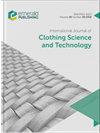织物弯曲各向异性的新测量方法
IF 1
4区 工程技术
Q3 MATERIALS SCIENCE, TEXTILES
International Journal of Clothing Science and Technology
Pub Date : 2023-09-12
DOI:10.1108/ijcst-03-2022-0044
引用次数: 0
摘要
目的在广泛使用的织物弯曲性能测试方法中,使用一种织物只能得到一个方向的一个结果,效率很低。为了获得织物的弯曲各向异性,需要进行大量的测试实验。本文的目的是研究一种新颖、高效、直观的织物弯曲各向异性测量方法。设计/方法/方法首先将织物裁剪成4个方向,0°(经纱方向)、90°(纬纱方向)、45°和135°(真偏)的8条特殊形状,然后放入自行设计的仪器上。然后用照相机从棱镜的右上方拍照。得到新的参数:投影面积、投影长度、投影长度、下落高度和下落指数(简称S、L、H、I)。然后提取它们(SDS, SDL, SDH和SDI)的标准差,用于表征弯曲各向异性。结果表明,该方法具有较好的可行性,S、L和I可以很好地表示织物的弯曲性能。其中SDL与弯曲长度SD的相关性最高,SDS次之,SDH第三。即SDL最能表征弯曲各向异性。考虑到数据采集的方便性和相关性,弯曲长度L是最佳参数。四个方向上的平均L和SDL可以结合起来表达织物的综合弯曲行为。该方法可以同时测量和表征织物的弯曲性能和弯曲各向异性。除效率高外,还能直观、直观地显示织物的弯曲或弯曲各向异性。本文章由计算机程序翻译,如有差异,请以英文原文为准。
Novel measurement of fabric bending anisotropy
Purpose Under the widely used testing methods for fabric bending behavior, only one result for one direction can be obtained by using one fabric which is low efficient. To obtain fabric bending anisotropy, it is necessary to conduct a great many testing experiments. The purpose of this paper is to investigate a novel, efficient and visual method that can measure fabric bending anisotropy. Design/methodology/approach Fabrics are first cut into special shapes with eight strips including four directions, 0°(warp direction), 90°(weft direction), 45 and 135°(true bias), then are put onto the self-designed instrument. After that a camera is used to take picture from the right above the prism. New parameters, projection area, projection length, projection length, falling height and falling index (S, L, H and I in short) are obtained. Furthermore, standard deviation of them (SDS, SDL, SDH and SDI in short) are extracted for the characterization of bending anisotropy. Findings Results show that the new method has good feasibility and S, L and I can be used to express fabric bending property well. Of all the four new parameters, SDL has the highest correlation with SD of bending length, SDS the second and SDH the third. That is, SDL can characterize bending anisotropy best. Taken convenience of data acquisition and correlation into consideration, bending length L is the best parameter. Average L and SDL in four directions can be combined to express the comprehensive bending behavior of fabrics. Originality/value The new method can measure and characterize both the fabric bending property and bending anisotropy. Besides its high efficiency, it can display fabric bending or bending anisotropy visually and directly.
求助全文
通过发布文献求助,成功后即可免费获取论文全文。
去求助
来源期刊
CiteScore
2.40
自引率
8.30%
发文量
51
审稿时长
10 months
期刊介绍:
Addresses all aspects of the science and technology of clothing-objective measurement techniques, control of fibre and fabric, CAD systems, product testing, sewing, weaving and knitting, inspection systems, drape and finishing, etc. Academic and industrial research findings are published after a stringent review has taken place.

 求助内容:
求助内容: 应助结果提醒方式:
应助结果提醒方式:


